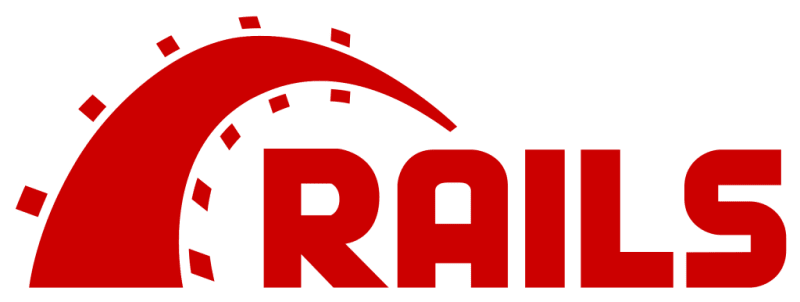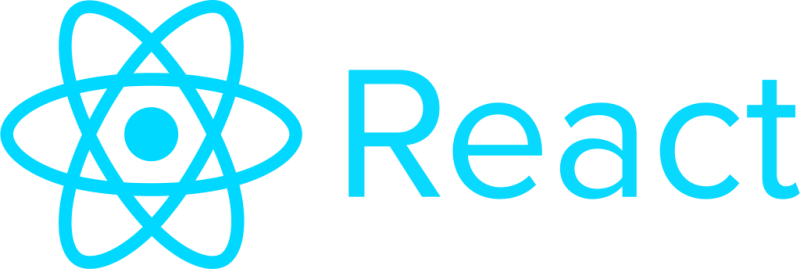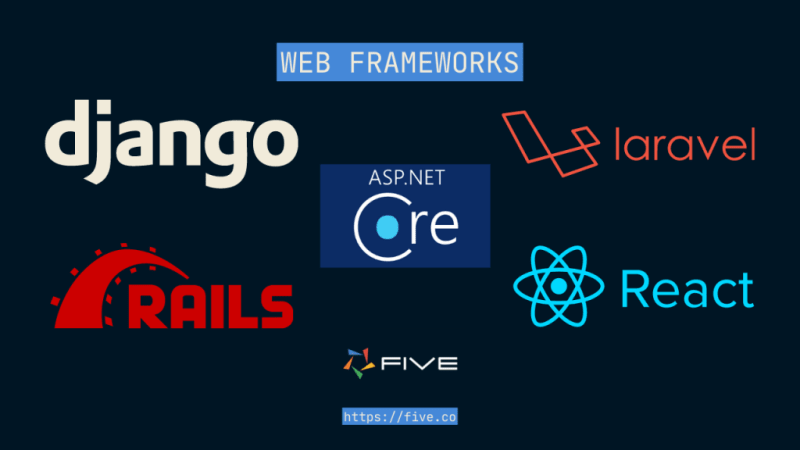The Top 5 Web Frameworks in 2023: Ruby on Rails, Laravel, React, Django, and ASP.NET
Web frameworks are a developer's best friend. Designed to make a developer's life easier, they streamline the development of dynamic and robust web applications.
This article delves into five influential web frameworks: Ruby on Rails, Laravel, React, Django, and ASP.NET. Each framework possesses distinct characteristics and strengths, catering to diverse development needs and preferences.
What is a Web Framework?
A web framework is a fundamental tool for web development that provides developers with a structured and efficient approach to building web applications. At its core, a web framework serves as a foundation that abstracts away common web development tasks, allowing developers to focus on the specific logic and functionality unique to their application. Web frameworks typically embrace the philosophies of code reuse, simplicity in elegance in web application development.
Web frameworks simplify the process of web development by providing a structured approach, conventions, and "opinions" on how to build things quickly and efficiently. By leveraging the power of a web framework, developers can expedite the development process, improve code quality, and deliver exceptional web experiences.
Web Frameworks: A Comprehensive Comparison
- Ruby on Rails: The Gem of Web Application Development
- Laravel - The PHP Framework for Web Artisans
- React - Facebook's Open-Source UI Library
- Django - The Web Framework For Pythonistas and Perfectionists
- ASP.NET - Microsoft's Enterprise Application Development Framework
1. Ruby on Rails: The Gem of Web Application Frameworks

Ruby on Rails, commonly known as Rails, is an opinionated full-stack web framework built on the Ruby programming language. It provides a comprehensive set of libraries, frameworks, and tools that streamline the development process. If you have no prior experience with Ruby, you will find a very steep learning curve diving straight into Rails.
Developed by David Heinemeier Hansson and released in 2004, Rails quickly gained popularity for its elegant syntax and emphasis on developer productivity. It follows the two principles of "Don't Repeat Yourself" (DRY) and "Convention over Configuration," providing sensible defaults and reducing the need for extensive configuration.
By embracing these principles, developers can significantly reduce the amount of manual configuration and boilerplate code, leading to faster development cycles and improved maintainability.
Ruby on Rails offers an extensive collection of built-in libraries and frameworks, or gems, for tasks such as database management, routing, and view templating.
How Popular is Ruby on Rails?
Stars on GitHub: >50k
Forks on GitHub: >20k
In Stack Overflow's 2023 Developer Survey, Ruby on Rails is the 18th most popular web framework, chosen by 5.5% of developers in response to the question "Which web frameworks and web technologies have you done extensive development work in over the past year, and which do you want to work in over the next year?"
Ruby on Rails - Quick Facts
1. Which Programming Language is Ruby on Rails Based On?
Ruby, a general-purpose programming language first released in 1995
2. When Was Ruby on Rails First Released?
2004
3. What's a Fun Fact About Ruby on Rails?
In Ruby on Rails, libraries, i.e. pre-packaged code used to extend or modify functionality, are referred to as Gems.
4. What Are Typical Applications Built with Ruby on Rails?
Typical applications built with Ruby on Rails are database-backed web applications and include e-commerce platforms, content management systems, social networking sites, and online marketplaces.
5. What Database Does Ruby on Rails Use?
When creating a new project, Ruby on Rails uses SQLite by default. However, Rails is database-agnostic, meaning that SQLite can be changed to a different database, such as MySQL, PostgreSQL, or MongoDB.
2. Laravel - The PHP Framework for Web Artisans

Laravel is a powerful PHP web framework renowned for its expressive syntax and elegant design. It offers a structured approach to web development, empowering developers to focus on the unique aspects of their application without getting entangled in repetitive tasks. Laravel's built-in authentication mechanisms, for example, streamline user management, ensuring secure access control without the need for extensive custom code.
Taylor Otwell released Laravel in 2011, with a focus on simplicity, readability, and developer-friendly features. Laravel's extensive ecosystem, comprehensive documentation, and vibrant community contribute to its popularity among PHP developers. The framework offers a robust routing system, built-in authentication mechanisms, caching capabilities, and database migration tools.
Laravel prides itself on its extensive and thorough documentation, tutorials, and video library, which makes it a beginner-friendly framework to start with. At its core, Laravel is also known to embody the essence of elegance, expressiveness, and developer-friendliness (just check out their beautiful documentation, which is a case in point for this). It provides a solid foundation for crafting sophisticated web applications while promoting code simplicity and maintainability.
How Popular is Laravel?
Stars on GitHub: >73k
Forks on GitHub: >23k
In Stack Overflow's 2023 Developer Survey, Laravel is the 14th most popular web framework, chosen by 7.6% of developers in response to the question "Which web frameworks and web technologies have you done extensive development work in over the past year, and which do you want to work in over the next year?"
Laravel - Quick Facts
1. Which Programming Language is Laravel Based On?
PHP, a general-purpose programming language first released in 1995
2. When Was Laravel First Released?
2011
3. What's a Fun Fact About Laravel?
Laravel is a made-up name that was chosen by its inventor, Taylor Otwell, in reference to a castle in the Chronicles of Narnia. Laravel was originally named Bootplant, but Taylor changed its name to Laravel before the first release.
4. What Are Typical Applications Built with Laravel?
Laravel finds application in a wide range of projects, including customer relationship management systems, enterprise resource planning solutions, and business process management tools.
5. What Database Does Laravel Use?
Laravel supports multiple database systems: it is database-agnostic and can be used together with MySQL, PostgreSQL, or MongoDB, for example.
3. React - Facebook's Open-Source UI Library

React, developed by Facebook and first released in 2013, is a JavaScript library renowned for building beautiful user interfaces.
React differentiates itself from a traditional web framework by adopting the role of a powerful UI library rather than a comprehensive framework. React excels in creating reusable UI components that enhance application performance and user experience. It focuses on creating reusable UI components and managing the state of these components efficiently.
Its declarative approach simplifies updating and rendering components, resulting in faster rendering times and smoother interactions. React's virtual DOM efficiently manages state changes, facilitating seamless integration with other libraries and frameworks.
Unlike a typical web framework, React does not provide built-in features for tasks like routing, form handling, or database management. Instead, React complements other libraries and frameworks, seamlessly integrating with them to create complete web applications.
React's ability to collaborate with other libraries and frameworks makes it a powerful ally in developing modern web applications that deliver exceptional user experiences. This flexibility also allows developers to choose the most suitable tools for various aspects of their application while relying on React for creating dynamic and reusable UI components.
How Popular is React?
Stars on GitHub: >210k
Forks on GitHub: >44k
In Stack Overflow's 2023 Developer Survey, React is the 2nd most popular web framework, chosen by 40.58% of developers in response to the question "Which web frameworks and web technologies have you done extensive development work in over the past year, and which do you want to work in over the next year?"
React - Quick Facts
1. Which Programming Language is React Based On?
JavaScript, a general-purpose programming language first released in 1995
2. When Was React First Released?
2013
3. What's a Fun Fact About React?
React is actually not a framework - it's a library. However, its wide use and ubiquity in web development mean that even developers sometimes aren't sure whether it's a library or a framework.
4. What Are Typical Applications Built with Laravel?
React finds application in various domains, including single-page applications, progressive web apps, and mobile application development.
5. What Database Does React Use?
Because React is a UI-library, this question doesn't apply.
4. Django - The Web Framework For Pythonistas and Perfectionists

Django, a high-level Python web framework, was developed by Adrian Holovaty and Simon Willison, with its initial release in 2005. Django follows the principle of "Don't Repeat Yourself" (DRY) and adopts the model-view-controller (MVC) architectural pattern. It offers a rich set of tools and libraries, including robust URL routing, form handling, database management, and user authentication. Django's comprehensive admin interface enables quick scaffolding and management of application data.
Django distinguishes itself by embodying the principles of "batteries included", meaning it comes with a lot of out-of-the-box functionality. It provides a comprehensive toolkit that covers various aspects of web development, allowing developers to focus on the unique business logic of their applications.
Django, as a full-featured web framework, also offers a rich ecosystem that includes a robust admin interface, authentication mechanisms, and a wide range of reusable components. The admin interface allows developers to quickly scaffold an administration panel for managing application data, saving valuable development time. Moreover, Django's authentication system handles user management and access control effortlessly, ensuring secure and scalable user experiences.
How Popular is Django?
Stars on GitHub: >71k
Forks on GitHub: 29k
In Stack Overflow's 2023 Developer Survey, React is the 13th most popular web framework, chosen by 11.5% of developers in response to the question "Which web frameworks and web technologies have you done extensive development work in over the past year, and which do you want to work in over the next year?"
Django - Quick Facts
1. Which Programming Language is Django Based On?
Python, a general-purpose programming language that is especially popular for data science project and was first released in 1991
2. When Was Django First Released?
2005
3. What's a Fun Fact About Django?
Django is named after the famous jazz guitarist Django Reinhardt and was developed by two developers working at the Lawrence Journal-World newspaper in Lawrence, Kansas. Who would have thought a newspaper business would create one of the world's most popular web development frameworks?
4. What Are Typical Applications Built with Django?
Django finds application in domains such as content management systems, data-driven web applications, and scientific computing platforms.
5. What Database Does Django Use?
Django is database-agnostic, even though PostgreSQL has a few features which are not shared by other databases that Django supports. This makes the combination of Django and PostgreSQL a natural choice.
5. ASP.NET - Microsoft's Enterprise Application Development Framework
ASP.NET Core, developed by Microsoft, is a web application framework that allows developers to build powerful, secure, and scalable cross-platform web applications using .NET languages like C# and Visual Basic. The framework can be used to build powerful web applications that can run on Windows, Linux, or macOS.
ASP.NET Core stands out by combining the stability and maturity of ASP.NET with modern development practices and cross-platform compatibility. It provides a robust foundation that encompasses essential features such as routing, middleware pipeline, and dependency injection. ASP.NET Core's modular architecture allows developers to choose and configure only the components they need, ensuring optimal performance and flexibility.
ASP.NET supports multiple development models, including Web Forms, MVC, and Web API. With its initial release in 2002, ASP.NET has evolved over the years to become a robust and versatile framework. It offers seamless integration with other Microsoft technologies, providing access to a rich set of libraries and tools.
How Popular is ASP.NET Core?
Stars on GitHub: >71k
Forks on GitHub: 29k
In Stack Overflow's 2023 Developer Survey, ASP.Net Core is the 7th most popular web framework, chosen by 16.6% of developers in response to the question "Which web frameworks and web technologies have you done extensive development work in over the past year, and which do you want to work in over the next year?"
ASP.NET Core - Quick Facts
1. Which Programming Language is ASP.NET Based On?
TypeScript and C#, a general-purpose programming language invented by Microsoft
2. When Was ASP.NET Core First Released?
2016
3. What's a Fun Fact About ASP.NET?
When was anything developed by Microsoft ever fun? Except this.
4. What Are Typical Applications Built with ASP.NET?
ASP.NET or ASP.NET Core are widely used for enterprise-grade web applications, including customer relationship management systems, e-commerce platforms, and financial applications.
5. What Database Does ASP.NET Use?
ASP.NET applications can use all of the popular databases
Five: Rapid Business Applications Development on MySQL and With an Admin Panel UI
Web frameworks are powerful tools that can make a job easier. Through standardization, they boost developers' productivity in application development. Yet, for business applications or internal tools, which rely on a lot of boilerplate code, even frameworks may be too sophisticated a solution.
Five is a purpose-built development environment for building and deploying custom business applications. It is more opinionated than a framework, giving developers even greater development speed. For example, Five comes with a pre-built admin panel UI layout, which is production-ready right from the get-go. Five also includes one-click deployment to development, testing, or production, relieving developers of the tedious task of setting up separate environments.
Developers can use JavaScript, TypeScript, or SQL to write functions or queries inside of Five. By default, applications built with Five come with a hosted MySQL database that developers can create and manage from inside Five.
Conclusion: Web Frameworks - Focus on the Unique Aspects Of Your Application
Web frameworks are a vital tool that simplifies and accelerates the development process. They are indispensable to web developers, and accelerate the creation of feature-rich and scalable applications. Ruby on Rails, Laravel, React, Django, and ASP.NET Core are highly regarded frameworks, each with its own rich history and distinctive features. Whether you prioritize developer productivity, code simplicity, component reusability, or platform compatibility, these frameworks provide solid foundations to bring your web development ideas to life.




Top comments (1)
I think includes this list maybe FastApi and Nest.js)).Great article thank you.